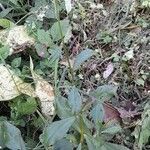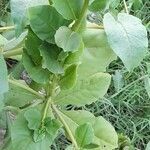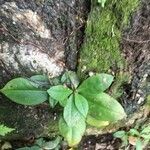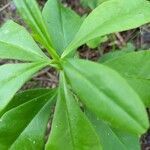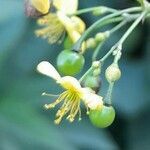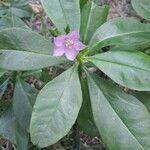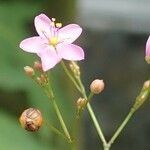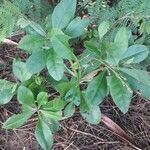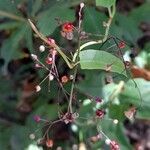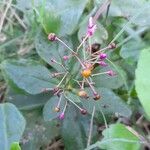Herb to 2 m tall, sometimes woody at base, often tuberous-rooted, glabrous; stems green flushed with purple. Leaves alternate, succulent; petiole to ca. 1 cm long glabrous; blade obovate or broadly elliptical, 2.7-13 x 1.5-5.5 cm, obtuse or acute at apex, cuneate or tapering to base, glabrous. Inflorescence a terminal, cymosely much-branched panicle, 7-60 x 6-20 cm, bracteate; pedicels 6-25 mm long, somewhat dilated distally, spreading. Sepals pale green, ovate to orbicular, 2-4 x 1-2 mm, connate at base, slightly keeled, becoming reflexed, caducous; petals pale yellow, mauve or pink, elliptical, ovate or orbicular, 3-5 x 1-3 mm; stamens 10-ca. 20, filaments 1.5-2.0 mm long, violet, free, anthers ovoid, 0.5 mm long, yellow; ovary sessile, globose, ca. 1 mm long. Fruit ovoid to globose, 3-5 mm wide; seeds flattened-orbicular, 0.75-1.0 mm wide, rich dark brown to black, shiny, striolulate in concentric rows.
Shrubby perennial from a tuberous root; stems erect, up to 1 m high, not branched or only sparsely at the base, becoming softly woody below.. Leaves elliptic to obovate, up to 11 cm long and 5 cm wide, base cuneate, apex abruptly acute, sessile or with a pedicel to 15 mm long.. Inflorescence terminal, a large, many-flowered, thyrsiform panicle, central axis 15–40 cm long, the lateral dichasia spreading with very slender, stiff peduncles and pedicels bearing up to 30 flowers.. Flowers ± 1 cm wide, opening towards evening; sepals suborbicular, deeply concave, 1–1.5 mm long; petals obovate to orbicular, pink; stamens 15–20.. Capsule globose, yellow or pinkish-yellow, 3–5 mm high; seeds lenticular, subreniform, ± 1 mm in diameter, black, glossy, the testa cells smooth or tubercled, elongated in concentric rings, minutely pitted at the cell corners.
Plants to 15 dm. Stems sometimes reddish, slender. Leaves to 12 cm, reduced abruptly beneath inflorescence; blade elliptic to obovate, base attenuate. Inflorescences paniculate, sometimes nodding. Flowers: sepals deciduous, sometimes reflexed, ovate to suborbiculate, 2.5-4 mm; petals red or pink, sometimes orangish, yellowish, or purplish, ovate to suborbiculate, 3-6 mm; stamens ca. 15-20; stigmas 3, linear; pedicel terete, ± uniformly slender, to 20 mm. Capsules subglobose, sometimes obtusely trigonous, 3-5 mm, exocarp and endocarp usually separating after dehiscence; endocarp valves persistent, remaining connate at apex, attached to receptacle by vascular strands from capsule apex; exocarp dehiscing from apex, valves deciduous ± separately. 2n = 24.
Herbs annual or perennial, 30-100 cm. Root few branched, obconic, thick, epidermis black-brown, flesh milky white. Stems branched basally, semiwoody. Leaf blade obovate or obovate-lanceolate, 5-10 × 2.5-5 cm, base narrowly cuneate, apex acute, sometimes retuse, mucronate. Panicle terminal or axillary, large, often dichotomous, long peduncled; bracts lanceolate, ca. 1 mm, membranous, apex acute. Pedicel 5-10 mm. Flowers small, 6-10 mm wide. Sepals purple-red, ovate, caducous. Petals pink or reddish purple, obovate or elliptic, 6-12 mm, apex rounded, rarely retuse. Stamens (10-)15-20, shorter than petals. Ovary ovoid, ca. 2 mm. Style ca. 2 mm; stigma 3-lobed. Capsule subglobose, ca. 4 mm, papery. Seeds oblate, ca. 1 mm. Fl. Jun-Aug.
Erect semi-shrub up to c. 70 cm. Leaves elliptic to obovate, up to 11 by 5 cm, acute to acuminate; nervation pinnate. Axillary buds with 2 subulate cataphylls. Terminal thyrsi up to c. 18 by 15 cm, with up to c. 10 dichasia, each with up to 30 flowers. Bracts and bracteoles subulate. Sepals suborbicular, c. 1.1 mm, acute. Petals (4-)5(-6), obovate, c. 4 by 2 mm, pink, apex emarginate. Stamens (4-)15; filament c. 2.7 mm; anthers c. 0.4 mm. Style c. 1.6 mm, 3-fid. Fruit c. 3 mm ø, yellow or pink, 3-valved. Seeds c. 1.2 mm ø; testa cells radially elongated, shortly tubercled or not, with small pits between the cells.
A herb. It can grow each year from seed or keep growing from year to year. It is 30-100 cm tall. The root is thick. The stems are erect and fleshy. The base is nearly woody. The leaves are alternate or almost opposite. The leaf blade is oval to sword shaped and 5-10 cm long by 2.5-5 cm wide. The base is almost wedge shaped and it tapers to a short tip with a sharp point. The flower panicle is large and at the tip or near the end. It has a long stalk. The flowers are purple-red. The flowering stalk is round in cross section.
Dwarf shrub, 0.2-0.5 m high. Leaves elliptic, up to 100 x 42 mm, apex acute, margins entire; petioles ± 5 mm long. Inflorescences much-branched, terminal panicles, many-flowered; peduncle up to 210 mm long; pedicels 10 mm long. Flowers bisexual, pink. Flowering time Nov.-Feb. Fruit a shiny capsule, ochre, chartaceous, 3 mm in diam., 1-locular, many-seeded, spherical. Seeds spherical to comma-shaped, ± 0.7 mm long, black, muricate.

